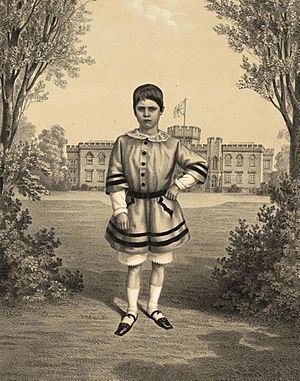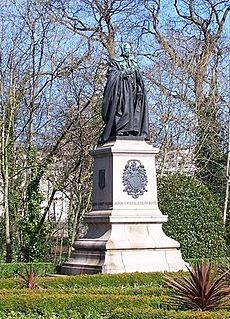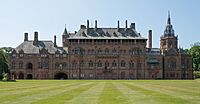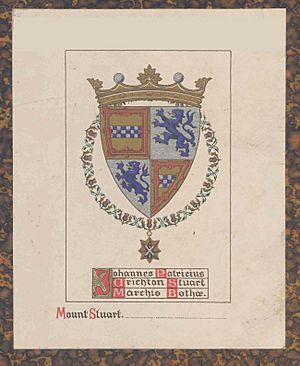John Crichton-Stuart, 3rd Marquess of Bute facts for kids
Quick facts for kids
John, 3rd Marquess of Bute
|
|
|---|---|
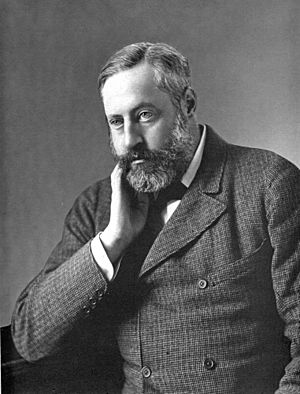 |
|
| Born | 12 September 1847 Mount Stuart, Scotland, United Kingdom |
| Died | 9 October 1900 (aged 53) |
| Resting place | Isle of Bute; Mount of Olives, Jerusalem |
| Known for | Philanthropy |
| Residence | Mount Stuart House (main residence) Cardiff Castle Chiswick House Dumfries House House of Falkland St John's Lodge |
| Spouse(s) | Gwendolen Fitzalan-Howard |
| Issue | John, 4th Marquess Lord Ninian Lord Colum Lady Margaret |
| Parents | John, 2nd Marquess Lady Sophia Rawdon-Hastings |
John Patrick Crichton-Stuart, 3rd Marquess of Bute (born 12 September 1847 – died 9 October 1900) was a very wealthy Scottish nobleman. He was also an industrial leader, a historian, a scholar, and someone who gave a lot of money to good causes. He was also a big supporter of architecture.
When John became the Marquess at just six months old, he inherited a huge fortune. People said he was the richest man in the world! When he was 21, he changed his religion from the Church of Scotland to Catholicism. This was a big scandal in Victorian times. The Prime Minister, Benjamin Disraeli, even wrote a novel called Lothair based on him.
John married into a famous Catholic family. He became a leader in the British Catholic community. He spent a lot of money building and restoring buildings. This made him the most important supporter of architecture in the 1800s. Lord Bute died in 1900 when he was 53. His heart was buried on the Mount of Olives in Jerusalem.
Contents
John's Early Life and Family
John was born at Mount Stuart House, his family's home on the Isle of Bute in Scotland. His father was John Crichton-Stuart, 2nd Marquess of Bute. His mother was Lady Sophia Rawdon-Hastings. When he was born, he was known as the Earl of Dumfries.
His father was an industrialist. He took a big risk by developing Cardiff as a port. This port was used to export minerals from the South Wales Valleys. His father believed Cardiff would become very rich. He was right, but his son, John, got to enjoy all the wealth.
John's father died in 1848. John became the Marquess when he was less than six months old. He went to Harrow School and then to Christ Church, Oxford University. His mother died when he was 12 years old.
From a young age, John was interested in the Roman Catholic Church. His guardians tried to stop him, but this only made him more interested. He studied the religion carefully. On December 8, 1868, he officially joined the Catholic Church. This caused a big public scandal at the time.
John's Many Interests
The Marquess had many interests. These included religion, medievalism (a love for the Middle Ages), the occult (mysterious or supernatural things), architecture, and travel. He also loved languages and helping others. He was a very busy person.
He wrote many books and loved to read. He also traveled a lot. Even though he was a businessman, he didn't always enjoy it. He was known for his knowledge of church history and design. But his most lasting legacy is his amazing building projects. He was called "the greatest builder of country houses" in 19th-century Britain.
In 1865, John met an architect named William Burges. They worked together on many projects. Their partnership created two amazing examples of the Gothic Revival style. These were Cardiff Castle and Castell Coch. These buildings show how huge industrial wealth could be used to create fantastic places.
John also worked with other architects after Burges died. Robert Rowand Anderson rebuilt Mount Stuart House for him. John also helped restore Falkland Palace and Greyfriars in Elgin. In 1890, he even became the mayor of Cardiff for a year.
Supporting Education and Community
The Marquess gave a lot of money to many different causes. He especially loved supporting religious buildings and universities. When he was the head of the University of St Andrews, he gave money for a new building for its Medical School. He also paid for the university's first female lecturer. She taught anatomy to women medical students.
At the University of Glasgow, he gave money to finish the university's large central hall. This hall is now called the Bute Hall in his honor. He is remembered there on Commemoration Day and at the university's Memorial Gates. He was also the Honorary President of the Highland Society at the University of Edinburgh.
Between 1868 and 1886, he paid for the rebuilding of St Margaret's Church, Roath in Cardiff. He created a new burial place for his family there. In 1866, he gave land in Cardiff Docks for a hospital ship for sick sailors. When he died in 1900, he left £20,000 to build a new hospital. This became the Royal Hamadryad Hospital.
John's Family Life
John, 3rd Marquess of Bute, married Gwendolen Fitzalan-Howard in 1872. She was the daughter of the 1st Baron Howard of Glossop. They had four children together:
- Lady Margaret Crichton-Stuart (born 1875 – died 1954)
- John, 4th Marquess of Bute (born 1881 – died 1947)
- Lord Ninian Edward Crichton-Stuart (born 1883 – died 1915)
- Lord Colum Edmund Crichton-Stuart (born 1886 – died 1957)
Death and Legacy
Lord Bute died on October 9, 1900, after a long illness. He had his first stroke in 1896. He was buried in a small chapel on the Isle of Bute, his family's home. His heart was buried on the Mount of Olives in Jerusalem.
In his will, he left £100,000 to each of his younger children. His eldest son inherited the main Bute estates. These included Cardiff Castle, the family home Mount Stuart House, and Dumfries House.


